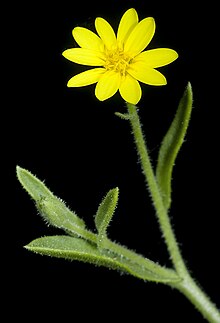| Osteospermum calendulaceum | |
|---|---|

| |
| Scientific classification | |
| Kingdom: | Plantae |
| Clade: | Tracheophytes |
| Clade: | Angiosperms |
| Clade: | Eudicots |
| Clade: | Asterids |
| Order: | Asterales |
| Family: | Asteraceae |
| Tribe: | Calenduleae |
| Genus: | Osteospermum |
| Species: | O. calendulaceum |
| Binomial name | |
| Osteospermum calendulaceum (L.f.) Less. | |
| Synonyms | |
| |
Osteospermum calendulaceum is a plant in the family Asteraceae. It was first described in 1782 by Carl Linnaeus the Younger. In 1832, Christian Friedrich Lessing assigned it to the genus Oligocarpus in his Synopsis Generum Compositarum.
In South Africa, it is native to the Cape Provinces, Free State, KwaZulu-Natal, Lesotho, Northern Provinces and Eswatini. It has been introduced into Hawaii, South Australia and Western Australia. In Australia, it is an agricultural weed found mainly on arid lagoon shores and plains.
References
- ^ "Oligocarpus calendulaceus". Australian Plant Name Index, IBIS database. Centre for Plant Biodiversity Research, Australian Government.
- ^ Chr. Fr. Lessing (1832), Synopsis Generum Compositarum (in Latin), unknown, p. 90, doi:10.5962/BHL.TITLE.51470, Wikidata Q6136846
- ^ "Osteospermum calendulaceum L.f. | Plants of the World Online | Kew Science". Plants of the World Online. Retrieved 29 September 2023.
- Linnaeus, C. (1782), Supplementum Plantarum, p. 386
- ^ A. Ghafoor (2020). "Oligocarpus calendulaceus". Flora of Australia. Canberra: Australian Biological Resources Study, Department of Agriculture, Water and the Environment. Retrieved 12 November 2021.
External links
| Taxon identifiers | |
|---|---|
| Osteospermum calendulaceum |
|
| Oligocarpus calendulaceus | |
This Asteroideae article is a stub. You can help Misplaced Pages by expanding it. |